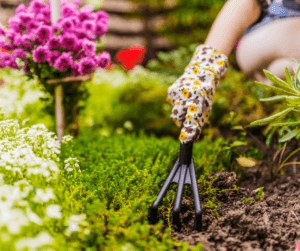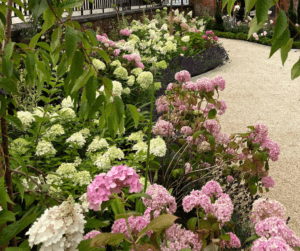2025’s Latest Gardening Trend: Wellness & Mental Wellbeing Through Sensory Gardens
Step into the new season with one of the biggest garden trends—gardening for wellness and mental well-being! As more people embrace self-care, a sensory garden offers the perfect escape. It’s more than just planting; it’s a way to calm the mind, boost happiness, and reconnect with nature.
Imagine the vibrant colours of blooming flowers, the soothing trickle of a water feature, and the fresh scent of lavender in the air. Every element works together to create a space that melts away stress. Whether you crave mindfulness, a break from the daily hustle, or simply love being outdoors, a sensory garden is your must-try project this season!

What is a Sensory Garden?
A sensory garden engages the five senses—sight, sound, smell, taste, and touch—to promote relaxation, mindfulness, and therapy. These gardens reduce stress, improve mental well-being, and enhance learning. They feature vibrant plants, soothing sounds, fragrant herbs, edible elements, and varied textures to create a calming experience. Sensory gardens are used in schools, healthcare, and urban spaces to support mental health and connection to nature. Ideal for stress relief, autism support, and dementia care, they offer a peaceful escape. Whether for personal use or therapy, they provide a multi-sensory retreat for wellness and balance.

Designing Your Sensory Garden
When designing a sensory garden, consider key factors like sunlight exposure, accessibility, and location. Choose a quiet, peaceful spot away from noise to create a calming retreat. Ensure the garden is walkable and easy to navigate, with paths that encourage movement and interaction with plants.
Incorporate textured pathways, seating areas, and interactive elements to enhance the experience. Adding a bench or relaxation spot at the end of the garden journey creates the perfect place to unwind. Thoughtful garden layout and accessibility make for a truly immersive and therapeutic sensory experience.
Need more help? Contact our head landscapers Richard on 07932 468660 or Jack on 07432 864591 for their expert advice & garden design services.

Best Plants for a Sensory Garden: Engage all Five Senses
Creating a sensory garden means choosing plants that stimulate sight, smell, taste, touch, and sound. Here are the best plants to enhance your garden’s multi-sensory experience.
- Sight: Bright colors, unique shapes, and varying foliage sizes create visual interest. Add Echinaceas, Tulips, Alliums, Sunflowers, and Heuchera for a vibrant display.
- Smell: Fragrant plants bring a calming atmosphere without being overwhelming. Try Rosemary, Lemon Balm, Mint, Sage, Curry Plant, and Jasmine for a refreshing scent.
- Taste: Edible plants enhance the sensory experience. Grow Basil, Dill, Mint, and Strawberries for fresh flavors and seasonal treats.
- Touch: Different textures create a grounding experience. Lamb’s Ear has soft, velvety leaves, Miscanthus Grass offers silky tassels, and Dwarf Apple Trees have smooth bark for tactile exploration.
- Sound: For a soothing, rustling effect, plant ornamental grasses and bamboo to enjoy the gentle sounds of nature.
By combining these plants, you can design a therapeutic sensory garden that encourages relaxation, mindfulness, and interaction with nature.

Enhance your Experience with Features & Accessories
At St. John’s, we offer more than just plants—we provide everything you need to build a tranquil garden retreat.
- Water Features & Birdbaths – Add a calming water element to your sensory garden with our fountains and birdbaths. Enjoy the peaceful sound of flowing water while attracting birds and wildlife.
- Wind Chimes & Bird Feeders – Enhance your garden with soothing chimes and birdsong. Our selection helps create a relaxing, nature-filled atmosphere.
- Soft Solar Lighting – Extend your garden enjoyment into the evening with our energy-efficient solar lights, perfect for a cosy, illuminated retreat.
- Raised Beds & Accessible Pathways – Make your garden easy to navigate with stepping stones and raised beds, ideal for those with mobility challenges.
Explore our collection today and design a sensory garden that soothes the senses and promotes relaxation!

Maintaining Your Sensory Garden
To maintain a sensory garden, water plants regularly, prune overgrowth, and refresh mulch to retain moisture and reduce weeds. Clean water features to prevent algae buildup and adjust plant care for each season. Encourage wildlife by refilling bird feeders and growing pollinator-friendly plants. With consistent care, your sensory garden will stay vibrant, relaxing, and full of life year-round.
A sensory garden offers a peaceful escape, promoting relaxation, mindfulness, and mental well-being. Start small with a few fragrant plants or soothing water features, then expand as you go. Ready to bring your vision to life? Visit our garden centres for expert advice and the perfect plant selections to create your own tranquil retreat.
